
Monster Hunter Wilds was provided by Capcom for review. Thank you!
It’s truly insane to see what Monster Hunter has become when looking back at its roots. Until Monster Hunter: World, it was a relatively niche series in the West, though it was massively popular in Japan. However, with World, that changed completely. It broke into the mainstream, shattering any initial expectations. Monster Hunter World pushed the series in new directions, with seamless areas to run around in, environmental traps, and even multiple large monsters at once that can interact with each other, all of which made it one of the best games of the past 10 years. Now, Capcom is aiming to push the series forward again with the new entry, Monster Hunter Wilds, and they have ended up creating one of my favorite games I’ve ever played.
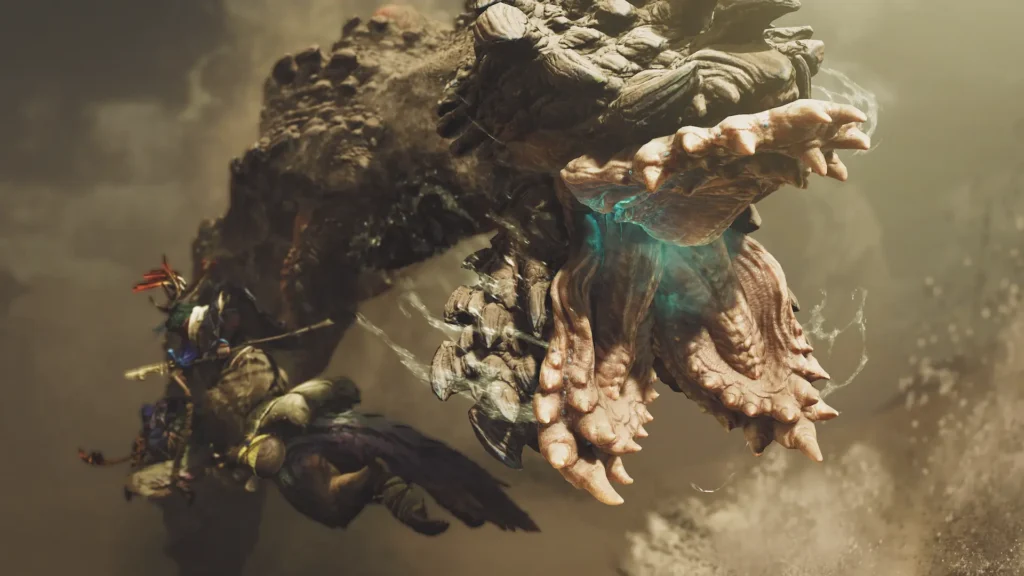
Let me just say that Monster Hunter Wilds is addictive. Throughout my time with it, I also had other games I needed to play, yet I kept making excuses to come back and play more. It was hard not to get invested and find reasons to return and keep playing. There was always a hint I wanted to partake in and materials I needed to find, and it felt so enjoyable and rewarding to take down those massive beasts. However, unlike the previous games (World and Rise), Wilds found a way to make me think out of the box and use more of the tools they provide.
Just like the previous games, the core gameplay loop is retained. You go out to hunt giant monsters with different gigantic weapons, harvest the materials from them, craft new weapons and gear, and then go off to hunt again. The loop is fairly simple to understand, though there are many complexities woven in that keep those longer hunts from feeling stale.
Depending on which of the 14 weapon types you choose, you can break or sever monster parts to inhibit some of their attacks or open them up for more powerful strikes. You can also jump onto monster’s backs to strike and incapacitate them and use different parts of the environment to your benefit. These can include bringing down boulders on top of them, trapping them in vines, ramming them into trees, and trapping them in spider webs. We also have the slinger, which we can use to shoot different pods to affect monsters directly.
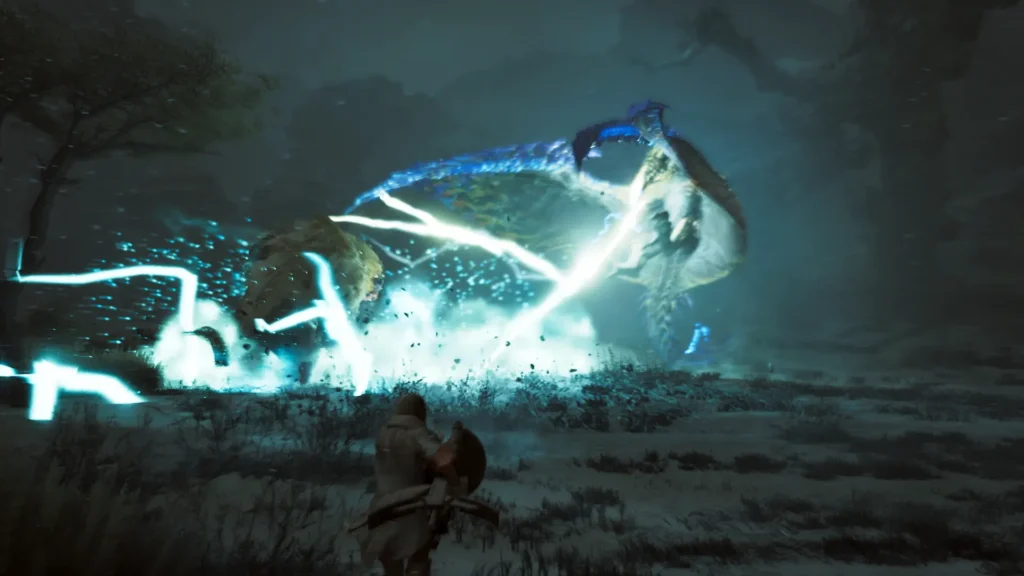
Each weapon type you can choose has its special mechanics to keep things interesting. Some weapons can be charged up, like the Charge Blade; some have different levels to power it up, like the Insect Glaive and Long Sword, and some are just slow and dangerous, like the series staple, the Great Sword. All of them have pros and cons, with some being faster and making you more agile with less damage and others being slower but significantly more powerful, but they are all unique with their upgrade trees. Usually, I would only focus on one weapon type and get proficient with it, but with Seikret being able to bring a second weapon, I ended up playing around with more combinations, which was a blast.
Capcom didn't need to change much to keep the loop addictive, but they did add one major feature that keeps those longer hunts engaging: Wounds. If you attack a certain spot long enough, a wound will appear on the monster. Attacking it deals extra damage, and if you attack it enough, it will slightly explode with even more damage, extra materials for you, and even some extra powerful sling ammo.
The team also added two mechanics that were introduced in Monster Hunter Rise. We can ride a Seikret (similar to Rise's Palamute), and Wedge Beetles can be found around the environments. The Wedge Beetles allow you to shoot a grappling hook onto them and swing, similar to what you could do in Rise with the Wirebugs. The Seikret is very similar to the Palamute, allowing you to heal, sharpen your blade, and eat while moving around faster. New to Wilds, you can also bring a second weapon that can be swapped out on the Seikret. This can allow a nice change of strategy mid-hunt or give you the option of taking one melee weapon, and one ranged weapon.
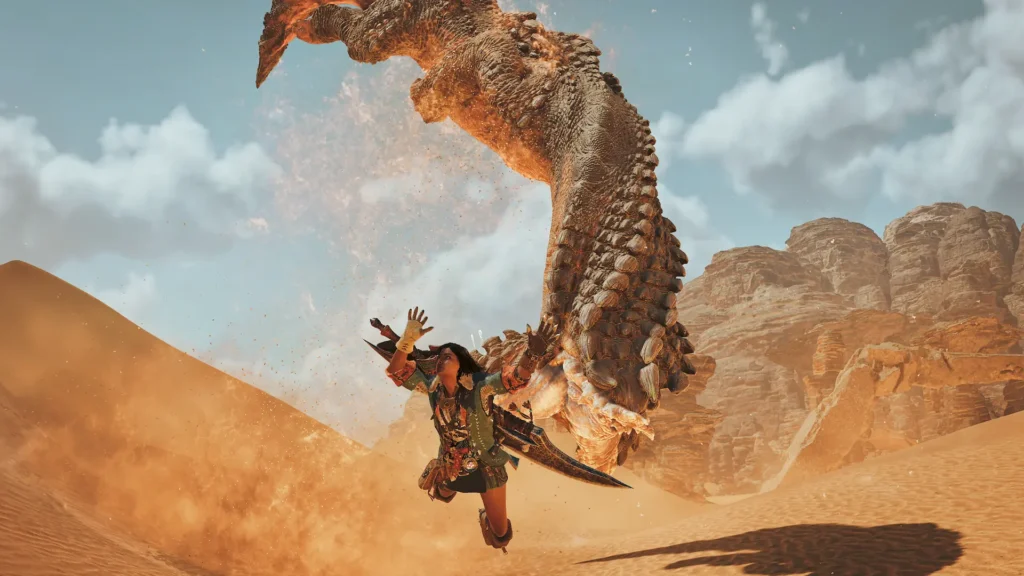
Some of these hunts can be especially long; one even took me 30 minutes, but these mechanics make those long hunts feel so engaging. With all the ways you can fight monsters, mount them, use traps and bombs, inflict wounds, and utilize the environment, it always feels like there's something to hold you in to take down these insane beasts. It can be difficult and it takes some planning to make sure you craft and bring the right traps and maximize your chances of winning with the element they are weakest to, but it can feel so rewarding to take them down.
Hunting never gets old, thanks to those mechanics and the progression system. As you fight monsters, you will get materials from them, which you can use to craft and upgrade weapons and armor. On top of the obvious attack and defense boosts, the different weapons and armor can have elements attached to their attacks and various buffs. With elements, every monster is weak against something, so you can create different weapons designed for different hunts. As for the buffs, there are many different ones to augment your playstyle.
I don't go around calling just anything addicting unless I truly have that compulsion to keep doing it, and Monster Hunter Wilds made me feel that way. I always wanted to do one more hunt, try getting one more weapon, find a better combination to get specific buffs I wanted, and do it all with friends, which was icing on the cake. You can go hunting with up to three other hunters, and while the monsters do get stronger the more people you play with, it's also so much fun to team up and strategize.
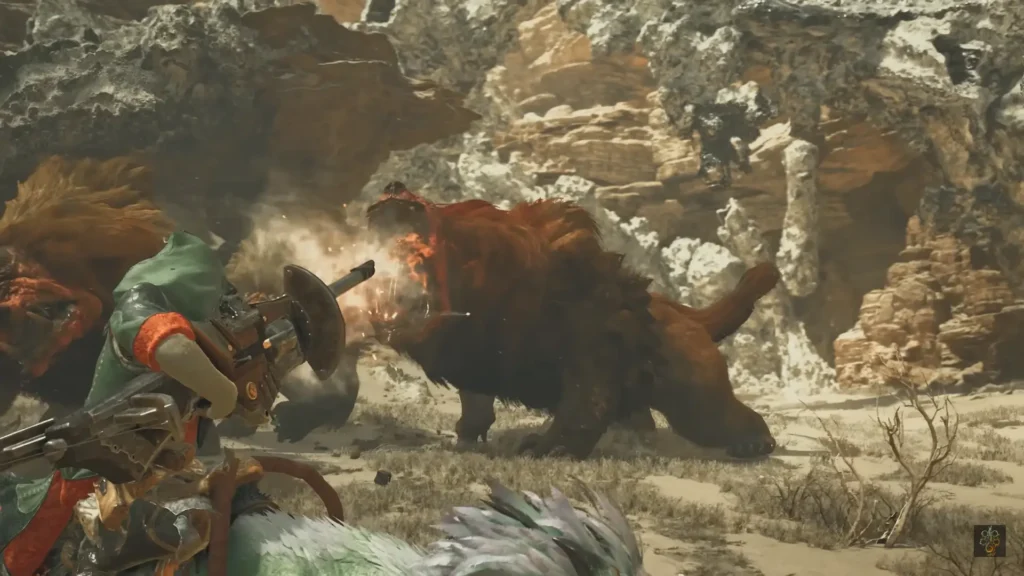
I feel Monster Hunter Wilds’ story is more just there to guide us to where we go next to explore more of the world instead of having any meaning behind it. There are some interesting moments that I was curious about, including the core issues taking place with the monsters. Still, ultimately, I never got too invested and mostly skipped through the cutscenes to get to the good stuff and hunt some monsters.
The way the game starts feels like a mixed bag at times. For newcomers, the story and beginning of the game is a great way to learn about the monsters, their strengths and weaknesses, and the progression systems, but as someone who already has experience from past games, I just wanted to get past it. Once you beat the campaign, you unlock High Rank, where I felt the best parts of the game are. The amount you can do grows significantly with new Tempered Monsters, which give new materials for more powerful weapons, Decorations to add even more buffs to your character, and Investigations so you can go out and find specific monsters on the map and save them to continually come back, even if they aren't on the map.
High Rank also unlocks the new Artian Weapons. These can be crafted from parts obtained after hunting Tempered Monsters and can be upgraded with new materials. I found this mechanic was a main drive for me to keep going at High Rank, but all of the mechanics worked well together to keep me invested. I can't go too much more into this part of the game just yet, but the time investment will be worth it.
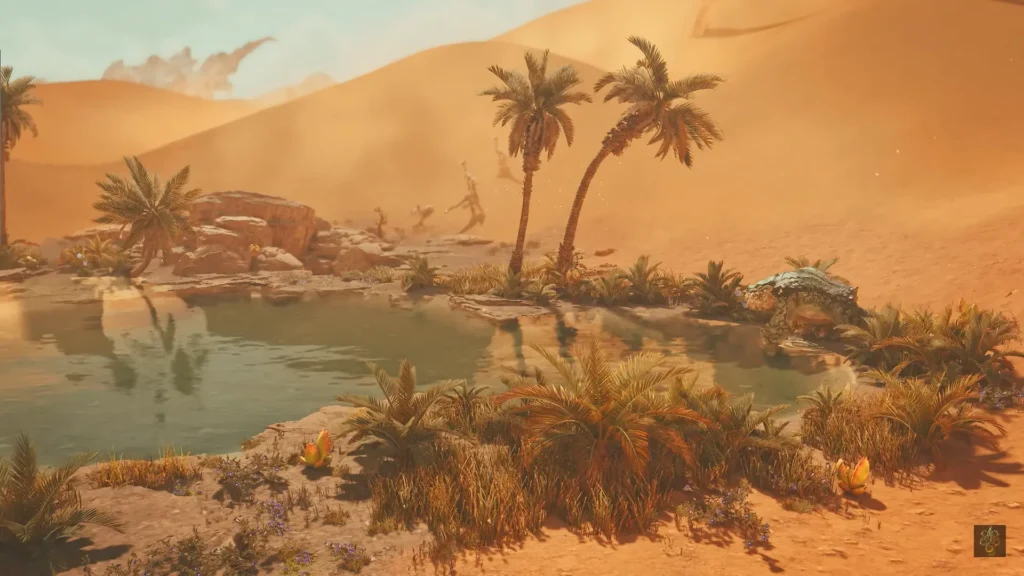
Monster Hunter Wilds also has some truly breathtaking views. From the deserts of The Windard Plains to the forests of Scarlet Forest and the oily oceans of Oilwell Basin, each place has some beauty and mysticism. The environments are detailed, and the monster's designs are fantastic. I especially like it when the environment changes in the desert. Seeing the sky change color and fog come down as lightning starts to strike the sand beneath me was beautiful, plus it added some nice new environmental variables that could harm the monster I was facing if needed.
It also makes me appreciate how open the world is in Monster Hunter Wilds. I can go into the field without starting a quest and collect materials for potions or bugs to create flash bombs. If I find a monster or see one on the map, I can start an investigation and create a quest dynamically to hunt them. It's a fantastic system that makes the overall gameplay loop more organic.
One thing I do want to mention is that Monster Hunter Wilds is a very tough game to run. I played primarily on my desktop PC, which sports the above-recommended system requirements for the game:
CPU - AMD Ryzen 7 3800X
GPU - NVIDIA RTX 3080 Founders Edition
RAM - 32GB DDR4-3600MHz
OS - Windows 10
I primarily played at 1080p with medium settings and NVIDIA DLSS on Quality, and I wasn't able to hold a solid 60 FPS. Now, there were a lot of moments that did stick to 60, but I had dropped below when fighting some of the more intense monsters. A driver update from NVIDIA or AMD may make this better, and frame generation might help in this scenario if you have a powerful rig like this that is underperforming but sticking above 30 FPS, but it's worth noting that you may need to tweak some settings.
Just know this is a very demanding game, so expect to make some concessions. The benchmarking tool I ran was mostly accurate in this regard, but I did expect it to run better than it did based on my score.
Unfortunately, if you are hoping to play Monster Hunter Wilds on the Steam Deck, I would not hope for much. This game was not designed to be played on lower powered devices, and we have seen it in the open beta and the benchmarking tool. This is not a Steam Deck game, so I recommend cloud streaming it or remote play from a better PC.
There are a couple of other aspects that still need some testing, so our SDHQ score will be finalized closer to release, but this is not a game I would expect to play on the Deck at all.
However, there is some hope for handheld play if you have more powerful handheld devices. I also tested the game out on the Ally X, running around with a few hunts. It is possible to play this way. I tested it at the lowest quality at 720p with FSR 3 at Performance on Turbo TDP mode, and it stuck to 30 FPS for the most part. I should be getting an even more powerful handheld soon, and Monster Hunter Wilds will be the first game I test on it. From my experience so far, I have high hopes.
Monster Hunter Wilds does have an accessibility tab, which includes options for color blindness, arachnophobia, HUD and text size options, closed captions, and options to reduce motion sickness. Outside of those, you can change crossplay, whether you repeat tutorials, changing which button you use to confirm, and volume sliders.
The game doesn't support 16:10 resolutions, but it does have cloud saves, controller support, and HDR is recognized on the OLED Steam Deck.
Monster Hunter Wilds may have had a bit of a slow start, but it became one of my favorite experiences afterward. The game retains what made it a sensation after World and adds some great new mechanics to keep the long, arduous hunts engaging and exciting. The world and quests feel dynamic with one of Monster Hunter's best stories. While I don't play this series for the story, some parts were quite intriguing. It's an addictive gameplay loop with fantastic progression that only gets better the more you play, and it's truly a joy when playing with others.
Even with some of its low points, Monster Hunter Wilds has become one of my favorite games that I have ever played, which had me addicted to grinding and getting more and better materials to master what it took to hunt monsters and make myself more powerful. If you have a more powerful PC or console like a PS5, this is a must-have game.
Our review is based on the PC version of this game.
If you enjoyed this review, be sure to check out the rest of the content on SteamDeckHQ! We have a wide variety of game reviews and news that are sure to help your gaming experience. Whether you're looking for news, tips and tutorials, game settings and reviews, or just want to stay up-to-date on the latest trends, we've got your back.
Monster Hunter Wilds is easily one of the best games I have ever played with a fantastic gameplay loop that gets better the more you play, though don't expect to play on Steam Deck.
